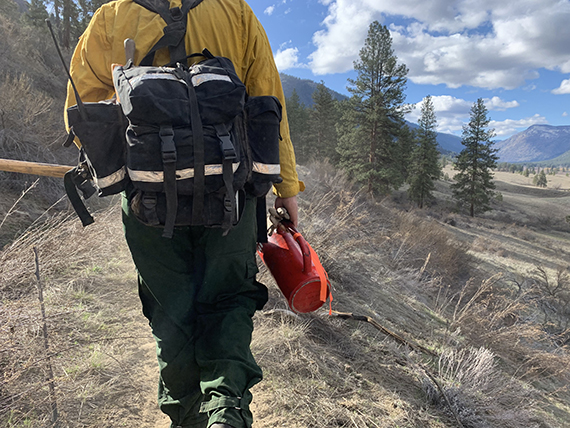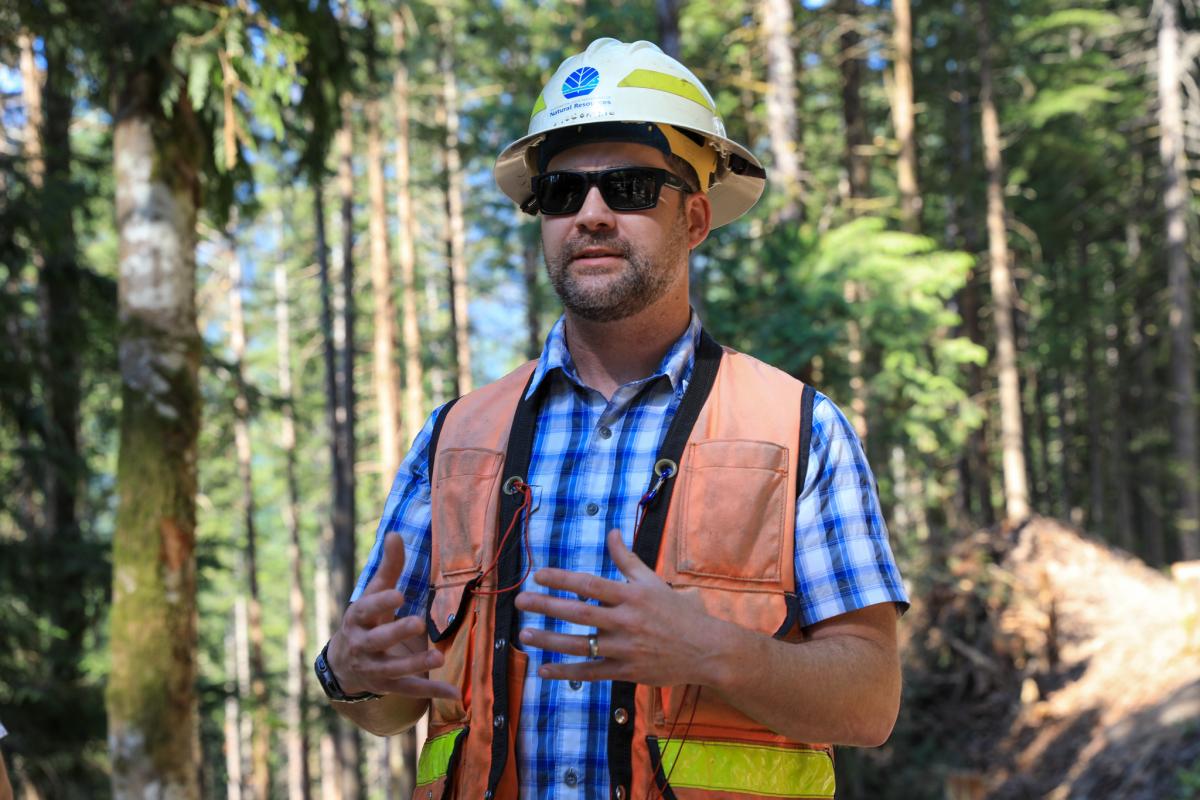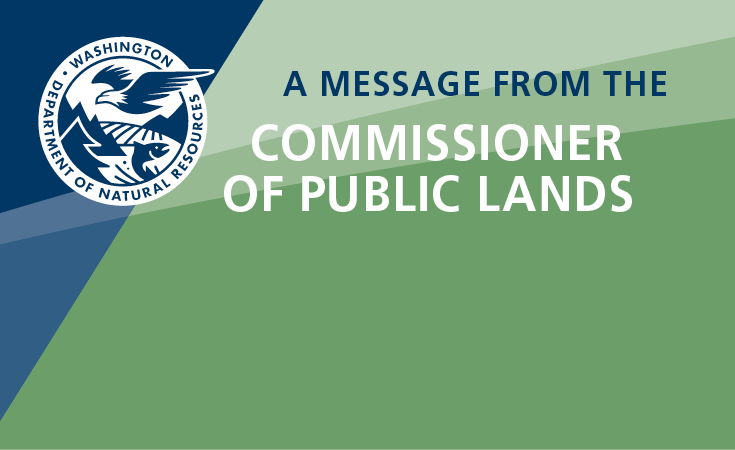Forest Resilience Division
Growing Healthy Forests in Washington
The Forest Resilience Division works across all lands to ensure forested ecosystems retain their resilience against disturbance mechanisms such as fire, insects, and diseases. Forest Resilience also monitors Washington forests to see how they are adapting to climate change, increasing drought severity, and more severe heat waves.
From helping public and private landowners care for their trees to leading the state’s efforts to reduce uncharacteristically severe wildfires, the Forest Resilience Division works to manage, sustain and protect the health of Washington’s forests to meet the needs of present and future generations.
Assistance and Information
- Visit the Insects and Disease Monitoring page for information about tree insects and diseases, the aerial forest health survey, and to access the annual Forest Health Highlights publication.
- Are you a forestland owner seeking a free forester consultation to learn how to have healthier forests, better wildlife habitat, or reduced wildfire risk? Are you interested in DNR's financial assistance program for reducing wildfire fuels? Visit the Financial Assistance for Forest Health page.
- Are you interested in the trees that grow in our cities and other communities? Visit the Urban and Community Forestry page.
- Are you a natural resources professional or landowner interested in prescribed fire? Visit our Certified Burn Manager Program page for more information about upcoming classes and other resources for safe and effective burning.
- Are you involved in a forest health collaborative in Washington state? Learn more about the grant programs DNR has to help collaboratives increase their capacity and conduct more forest health work by visiting the Forest Health Strategic Plan page.
- Are you a small forest landowner seeking assistance with forest practices regulations? Visit the Small Forest Landowners page under Forest Regulation.
Forest Health and Resilience in Washington
- The 2020 Forest Action Plan lays out a statewide strategy for improving and conserving Washington forests. Stay tuned for the 2025 Forest Action Plan revision later this year.
- The 20-Year Forest Health Strategic Plan is DNR's strategy for improving forest health and reducing wildfire risk in central and eastern Washington.
- The Federal Lands Program uses our Good Neighbor Authority (GNA) and Shared Stewardship agreements with the USDA Forest Service to work collaboratively and across land management boundaries to advance shared priorities and coordinate investments at a landscape scale.
- The Climate Resilience Plan highlights actions DNR can take in response to projections that suggest Washington will experience increased temperatures and decreased precipitation during the growing season. Climate change will contribute to tree stress, insect and disease problems, and increases in dead trees.
Legislation
- The Washington Legislature passed a suite of legislation in 2021 that aims to reverse the worsening forest health crisis in Washington. The Commissioner of Public Lands prioritized the landmark House Bill 1168, which commits $125 million in each of the next four biennia to boost wildfire response, accelerate the forest restoration work at the core of the Forest Health Strategic Plan and Forest Action Plan, and build community resilience.
- Other key legislation passed during the 2021 legislative session included HB 1216 to increase the scope and scale of DNR's Urban and Community Forestry program and Senate Bill 5141, also known as the HEAL Act, which aims to reduce environmental health disparities in Washington.
- The Legislature passed a new law in 2017 clarifying DNR’s roles and obligations in addressing forest health concerns on eastern forested State Lands as part of the Forest Health Strategic Plan. As a result, DNR developed its Strategy to Restore Forest Health on State Lands in Eastern Washington. That same year, the legislature passed House Bill 1711, requiring DNR to analyze and re-prioritize forest health treatments on state lands every two years.
Grant Opportunities
The Forest Resilience Division is pleased to offer a variety of grant opportunities each year in support of efforts to restore forest health and enhance forest resilience undertaken by our partners at all levels of government, non-governmental organizations, nonprofits, Tribes, private landowners, and more.
Forests provide a wide range of benefits to our environment and the communities that benefit from clean air and water, recreational opportunities, and economic opportunities supported by the long-term health and sustainability of forestlands. Under our all lands, all hands approach to forest health, we recognize the importance of investing in actions taken at all levels to manage, sustain, and protect what makes us the Evergreen State now and in the future.
Click here to view a folder containing information on all DNR grant programs. Grant programs currently accepting applications include:
- Post-Fire Restoration Financial Assistance Competitive Grant
- Application deadline: January 31, 2025
- Funding range: $10,000-250,000
- Match requirement: 50 percent (1:2)
- Eligible projects: planting, site preparation, partnerships and community engagement, seed collection and processing
- More information: https://deptofnaturalresources.box.com/v/25-20-RFA-PostFire
More About the Forest Health and Resilience Division
The Washington Department of Natural Resources created the Forest Resilience Division in 2019. The Commissioner of Public Lands determined a reorganization of agency structure was needed to best support the DNR mission to manage, sustain, and protect the health and productivity of state-managed lands and waters to meet current and future needs. The Commissioner of Public Lands is the state lead on all issues relating to forest health.
DNR created the division in 2019 to achieve the agency’s mission to manage, sustain, and protect the health and productivity of Washington’s lands and waters to meet the needs of present and future generations and support the Commissioner of Public Lands as the designated state lead on all forest health issues.
The Forest Resilience Division works across all lands and in the interest of all Washingtonians to sustain and increase the health and resilience of our forests and the local communities and values forests support for the well-being of people, communities, wildlife and landscapes today and into the future. Division staff work closely with the DNR Region offices, which oversee the operationalization and stewardship of the Forest Resilience portfolio.
The four sections of Forest Resilience
Planning, Science, and Monitoring

An aerial view of some of the DNR-managed land impacted in 2021 by the Cedar Creek Fire. The Planning, Science, and Monitoring Division of DNR conducted extensive post-wildfire monitoring of areas treated for forest health before the fire burned through. (Derek Churchill/DNR)
The Planning, Science, and Monitoring section provides forest health, insect and disease monitoring, including aerial surveys of forest health conditions that result in annual Forest Health Highlights reports. This team of forest pathologists, forest entomologists, and forest health specialists also provide technical assistance to forest landowners.
Our scientists and planners lead the development and revision of core documents such as the 20-Year Forest Health Strategic Plan: Eastern Washington and the Forest Action Plan. They also lead research efforts on some of the most prominent issues facing Washington forests.
Planning, Science, and Monitoring staff oversee implementation of the All-Lands Direct Investments and Building Forest Partnerships programs, coordinate the Forest Health Advisory Committee, and serve as lead stewards of data from DNR and partners statewide that inform public-facing tools such as the Forest Health Tracker.
Community and Landowner Assistance
The Landowner and Community Assistance section combines three existing DNR programs: Urban and Community Forestry, Landowner Assistance, and Forest Stewardship.
- The Urban and Community Forestry Program provides urban forestry technical, educational and financial assistance to Washington’s cities and towns, counties, tribal governments, nonprofit organizations and educational institutions. It also administers the Evergreen Community Recognition Program.
- The Service Forestry Program integrates the DNR assistance programs for private landowners into a single, statewide mechanism to provide those landowners technical assistance and financial incentives for forest health work on their properties. This program plays an integral role in delivering services that support proactive management of Washington's non-industrial private forests.
- Program staff provide land management advice to non-industrial, private landowners. They help them assess available resources, problems, and opportunities on their lands. Service Forestry aims to educate landowners on how to develop and implement management plans to guide current and future actions.
Cross-Boundary Restoration

A member of the burn crew walks into a prescribed fire operation near Loomis. Completed in May 2022, this was the first prescribed fire led by DNR under its new Cross-Boundary Restoration program (Ryan Rodruck/DNR)
The Cross-Boundary Restoration section is the home of recently established programs that cut across property lines and land management jurisdictions to deliver forest resilience outcomes from an all-lands point of view. The new programs include Prescribed Fire and Post-Fire Recovery.
The Prescribed Fire Program operates within Cross-Boundary Restoration. It aims to increase safe and effective prescribed fire in Washington state to restore forests and other ecosystems. Prescribed Fire provides expertise and coordination in prescribed fire planning and implementation in close coordination with key partners. The program focuses on prescribed fire training, funding prescribed burns, and monitoring the effects of prescribed fire and wildfire.
The agency launched its standalone prescribed fire program in 2019 following a successful pilot project. In 2022, DNR led its first prescribed fire on state trust lands in well over a decade. Prescribed fire is one tool for restoring health to dry forest ecosystems in eastern Washington.
Established in 2021, The Washington State Department of Natural Resources Post Fire Recovery Program works at all levels of the disaster recovery cycle. The program operates with an overarching goal of helping communities and watersheds recover from wildfires increasing in size, severity, and long-term impacts felt across Washington.
The Post-Fire Recovery Program is a key part of DNR’s implementation of the 10-Year Wildland Fire Strategic Plan, 20-Year Forest Health Strategic Plan, and Forest Action Plan.
Federal Lands

Federal Lands Program Manager Trevor McConchie speaks during a tour of the Bandera Restoration Project. (Rachel Terlep/DNR)
The Federal Lands Program focuses on using state expertise, resources and mechanisms to increase work on federal land throughout Washington. This occurs primarily on National Forest System land through the use of DNR’s Good Neighbor Authority (GNA) agreement with the federal government. This section works directly with U.S. Forest Service personnel in Washington to implement a variety of restoration projects such as decreasing stream barriers for fish and other aquatic organisms, addressing forest road issues, timber sales, wildlife habitat enhancement and more.
In addition to GNA, this program coordinates with other programs within the division and department to provide input on federal projects and National Environmental Policy Act (NEPA) planning support.
The program is funded through a variety of funding sources including state and federally appropriated funds, as well as revenue derived from restoration projects with commercial timber as a component. The program has active projects on the five major national forests in Washington.


